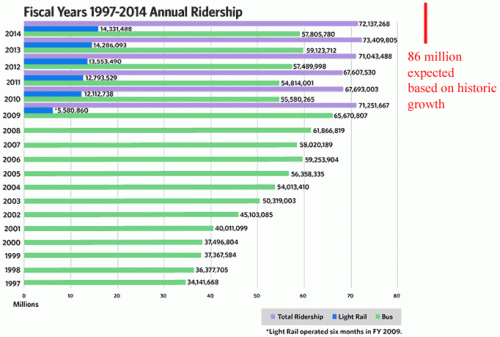Want to Increase Infrastructure Money for Highways Immediately by 31%? Stop Diverting Highway Money to Transit
This DOT table, pointed out to me by Randal O'Toole, shows that money spent on highways could be increased immediately by over 30% if highway money was not diverted to transit and other uses. About 13% of state gas tax revenues meant for highways are diverted to non-highway transit projects (e.g. light rail boondoggles). Another 9.4% are diverted to general funds, and may not be applied to transportation projects at all. The same table shows that if all state MVD receipts were used to support investments for cars rather than transit and general spending, money available for roads would increase 45% from those funds.
Transit projects should be supported by their own riders. This will never happen, because they are so egregiously expensive per passenger-mile that no one would ride them if their trip were not subsidized by the rest of us**. And I am exhausted with having folks argue that highways are "subsidized" because they require tax money beyond the gas taxes (which are essentially a user fee) when these extra tax monies for highways would be largely unneeded if the highway funds were used for highways. The diversion to general funds is particularly troubling, since sleazy government officials are obviously trying to piggy-back off the popularity of highway infrastructure investment to generate a slush fund for activities taxpayers are less likely to support.
And please do not tell me that as a highway driver, investments in transit are doing me a favor by getting cars off the road. Transit investments are so expensive per passenger mile that the same money spent getting a few cars off the road via transit would substantially increase road and highway capacities. A dollar of highway investment carries at least an order of magnitude more passenger miles than a dollar of transit spending.
** I am always amazed that supporters of such transit projects call light rail projects "sustainable". Forget for a minute that they seldom use less energy per passenger mile than driving. Think about all the resources that go into them. This at first seems like a hard problem -- how do we account for all the resources that go into transit vs. go into driving. But then we realize it is actually easy, because we have a simple tool for valuing resource inputs: price. Prices are a great miracle. They provide us with a sort of weighted average of the value and scarcity of the resources (both hard, like titanium, and soft, like labor and innovation) that go into a product. So if light rail costs 10x or more per passenger mile than driving, as it often does, this means that it uses ten times the value of resource inputs as driving. This is sustainable? I do not think that word means what you think it means.



